Link
I thought this was really good, so I wanted to share. Some of the images were missing, so I did my best to substitute based on the description.
Since the ancient Maya have been added to the Key Stage 2 national curriculum for History (non-European Study), there’s been a ‘mushrooming’ of online resources covering the topic. Most of which are downright awful!
After the recent flawed news story about a teenager finding a Maya site, I thought it an apt moment to let both teachers who are teaching the Maya as well as the general public know what they need to be looking out for to confirm a resource’s unreliability
Beware!
Here are 10 tell-tale signs that expose unknowledgeable sources
1. The term ‘Mayan’ is used instead of ‘Maya’

The term ‘Mayan’ is ubiquitously used by ill-informed sources: ‘Mayan people’, ‘Mayan pyramids’, ‘Mayan civilisation’…
All Maya specialists -and, for that matter, all non-specialists who’ve read a book or two on the ancient Maya- know that the right word is Maya.
Their calendar is called the ‘Maya calendar’, their civilisation is called the ‘Maya civilisation’, their art is called ‘Maya art’…
The only time you should use the adjective ‘Mayan’ is when you are talking about their languages, the ‘Mayan languages’.
So, if you see ‘Mayan people’, ‘Mayan pyramids, ‘Mayan art’, ‘Mayan civilisation’, etc, on a publication (website or magazine), you can be sure the person who wrote the article doesn’t know a thing about the ancient Maya.
2. The image of the Aztec calendar stone is presented as the Maya calendar

Unscrupulous sources will use the ‘Sun Stone’ to illustrate texts about the Maya calendar.
Unfortunately, the famous sculpture is Aztec. Not Maya.
Using the ‘Sun Stone’ to talk about Maya calendar system is like using photos of theElizabeth Tower at Westminster (AKA ‘Big Ben’), which was completed in 1859, to illustrate time keeping in ancient Rome!
And yes I have even seen this image adorning the front cover of books on the Maya! Beware! Which leads nicely onto point 3-
3. The Maya are identified as the Aztecs

This confusion is very common but the truth is the Aztecs were very different to the Maya. They spoke a different language and had a different writing system.
Also the Maya civilisation began at least 1500 before the Aztecs.
The Aztec capital of Tenochtitlan is as far away from the great Maya site of Tikal as London is from Milan, Italy!
Stating the Maya were the same as the Aztecs, is basically saying that all Europeans are the same, having the same language, culture and beliefs…
Would you like to see an image of Stonehenge on the front cover of a book on the French? I think not!
Then we get the Egyptians….
4. Maya pyramids are said to be similar to Egyptian pyramids

I am afraid not!
Firstly, the ancient Maya and ancient Egyptians lived during different time periods. The time of pyramid building in Egypt was around 2000 years earlier than the earliest Maya pyramid.
Secondly, Egyptian pyramids have a different shape and use to those of the Maya.
Maya pyramids are not actually pyramidal! They have a polygonal base, but their four faces do not meet at a common point like Egyptian pyramids. Maya pyramids were flat and often had a small room built on top.
Pyramids in Egypt were used as tombs for the dead rulers, for the Maya, though the pyramids were mainly used for ceremonies carried out on top and watched from below.
Lastly, they were built differently. Maya pyramids were built in layers; each generation would build a bigger structure over the previous one. Egyptian pyramids, on the other hand, were designed and built as a single edifice.
5. It is claimed that the Maya mysteriously disappeared in the 10th century AD

Uninformed sources talk about the ‘mysterious’ disappearance of the ancient Maya around the 10th century AD., which mislead people to think that the Maya disappeared forever….
Firstly, the Maya did not disappear. Around 8 million Maya are still living today in various countries of Central America (Mexico, Guatemala, Belize, El Salvador and Honduras); in fact half of the population of Guatemala is Maya.
Although they do not build pyramids like the ancient Maya did, modern Maya still wear similar dress, follow similar rituals and some use the ancient Maya calendar. I am sure they would all like to assure you that they have definitely not disappeared!
We know now that what is called ‘Classic Maya Collapse’ was actually a slow breakdown, followed by a reconstruction, of a number of political, economical and cultural structures in the Maya society.
Archaeologists see cities being abandoned over the course of the 9th, 10th and 11th centuries, and people travelling north into the Yucatan Peninsula (Mexico) building new great cities such as Mayapan, which was occupied up until the 15th century.
Secondly, there was nothing mysterious about it! A number of associated factors were at play.
There was a severe drought in the rainforest area that lasted decades, so people moved north where water sources were more easily available. The competition between waring factions and cities for natural resources led to increased warfare. Which, in turn, led to the breakdown of trade networks.
All this was likely exacerbated by political and economical changes in Central Mexico.
So, very much like the French did not disappear after the French Revolution -although they stopped building castles and some big political, economical and cultural changes occurred in the French society- the Maya did not mysteriously disappear around the 10th century.
6. The Maya are portrayed as blood-thirsty sacrifice-loving psychos

The Maya are often portrayed in the media and popular culture as blood-thirsty (see for example Mel Gibson’s 2006 Apocalypto), so the commonly accepted -and oft-repeated- idea is that the Maya carried out lots of sacrifices.
Actually, there is barely any trace of sacrifice in the archaeological record of the Maya area. The rare evidence comes from pictorial representations on ceramics and sculpture.
Warfare amongst the Maya was actually much less bloody than ours and no, they did not use a real skull as a ball in their ballgame! And no the loser was not put to death!
In warfare, they did capture and kill opponents, but it was on a small-scale. Rulers boasted of being “He of five captives” or “He of the three captives”.
The heart sacrifices that were recorded by the Spanish chroniclers were those of the Aztecs.
It is also important to keep in mind that the Spanish Conquistadors had lots of incentives to describe the indigenous people of the Americas as blood-thirsty savages.
It made conquest and enslavement easier to justify (see the Valladolid Debate) so lots of stories were exaggerated.
And who are we to judge when we used to have public spectacles of people being hanged or having their heads chopped off and placed on spikes on London Bridge!
7. The ancient Maya predicted that the world would end on 21 December 2012

The 2012 phenomenon was a range of beliefs that cataclysmic events would trigger then end of our world on December 21st.
This date was regarded as the end-date of a 5,126-year-long cycle in the Maya Long Count calendar and it was said that the ancient Maya had prophesied the event.
This is not true and all Maya people today and Maya specialists know this!
Very much like a century and a millennium ended in the Christian calendar on December 31st 1999, a great cycle of the Maya Long Count -the 13th b’ak’tun– was to end on 21 December 2012.
In Maya time-keeping, a b’ak’tun is a period of roughly 5,125 years.
Only two Maya monuments –Tortuguero Monument 6 and La Corona Hieroglyphic Stairway 12– mention the end of the 13th b’ak’tun. None of them contains any speculation or prophecy as to what would happen at that time.
While the end of the 13th b’ak’tun would perhaps be a cause for celebration, the next day the Maya believed that a new cycle -the 14th b’ak’tun- would begin; much like our New Year’s Eve.
In fact, in the temple of Inscriptions at Palenque, where we find the tomb of King Pakal, it was written that in AD 4772 the people would be celebrating the anniversary of the coronation of their new King Pakal!
8. The Maya are described as primitive people

The Maya created an incredible civilization in the rainforest where it is extremely humid, with lots of bugs and dangerous animals and little water.
There they built spectacular temples, pyramids and palaces without the use of metal tools, the wheel, or any pack animals, such as the donkey, ox or elephant.
The Maya were the only civilization in the whole of the Americas to develop a complete writing system like ours.
They were only one of two cultures in the world to develop the zero in their number system and so were able to make advanced calculations and became great astronomers.
The Maya were extremely advanced in painting and making sculptures, they played the earliest team sport in the world and most importantly, for me anyway, is that we have the ancient Maya to thank for chocolate!
So no, they were definitely not primitive!
The problem with this view of the ancient Maya is that their achievements are then explained by the help of Extra-terrestrial beings or other civilisations.
9. The great achievements of the Maya are in thanks to the Olmecs

The Olmec civilisation is an earlier culture located along the Gulf coast of Mexico.
This myth of the Olmecs being a ‘mother culture’ to the Maya and other cultures in Mesoamerica had been questioned over 20 years ago and has been long put to rest.
Excavations have shown that they were many other cultures, other than the Olmec living in Mesoamerica before the Maya and that rather than a ‘mother culture’ we should be looking at ‘sister cultures’ all influencing each other.
Furthermore, Maya achievements in hieroglyphic writing and calendrics which no other culture in Mesoamerica had seen or used, indicate that they were much more innovators than adopters.
So, if the resource mentions the above, then it is obvious that they are not specialists and are using redundant information written over 20 years ago.
10. Chichen Itza is used as the quintessential Maya site

Chichen Itza was inhabited quite late during the Maya time period, about 1400 years after the first Maya city and is not purely Maya.
The city was quite cosmopolitan and was greatly influenced by Central Mexico, particularly the Toltecs, who may have lived there.
Therefore, its architecture and art -such as the ‘chacmools‘ or the ‘tzompantli‘ (AKA ‘skull-racks’) actually are Central Mexican, and not Maya, features.
A much better example of a typical Maya city would be Tikal, which was occupied for more than 1500 years.
So, if all you see on a website is about Chichen Itza, chances are this is not a reliable source of information about the ancient Maya and your ‘charlatan alarm-bells’ should go off!
28K notes
·
View notes
Photo

We exist and like hell are you going to stop us from existing.
6K notes
·
View notes
Photo






Tom hardy’s oddly small princess peach lips have been banished from cinema for 10 years only to be released for a single, all important purpose, kissing venom
167K notes
·
View notes
Text
My Biggest and Most Annoying Fictional Horse Pet Peeve
Big Horses are a Very New Thing and they Likely Didn’t Exist in your Historical and/or Fantasy Settings.
You’ve all seen it in every historical piece of media ever produced. Contrary to popular belief, a big black horse with long legs and long flowing mane is not a widespread or even a particularly old type of horse.
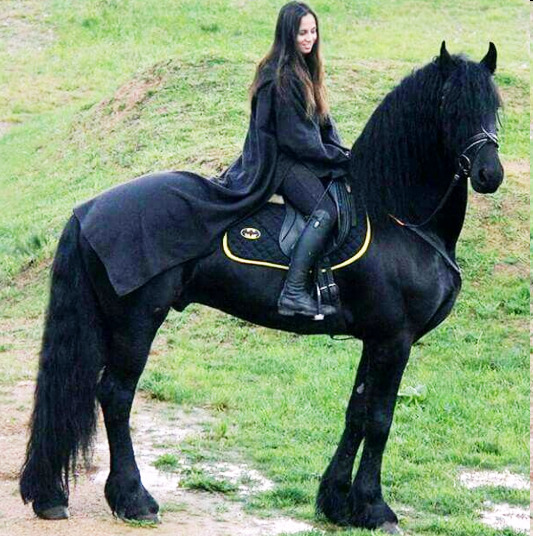
THIS IS NOT A MEDIEVAL THING. THIS IS NOT EVEN A BAROQUE THING. THIS IS A NINETEENTH CENTURY CITY CARRIAGE HORSE.
All the love to fancy Friesian horses, but your Roman general or Medieval country heroine just really couldn’t, wouldn’t, and for the sake of my mental health shouldn’t have ridden one either.
Big warmblood horses are a Western European and British invention that started popping up somewhere around 1700s when agriculture and warfare changed, and when rich folks wanted Bigger Faster Stronger Thinner race horses. The modern warmblood and the big continental draught both had their first real rise to fame in the 1800s when people started driving Fancy Carriages everywhere, and having the Fanciest Carriage started to mean having the Tallest and Thinnest Horses in the town.
Before mechanised weaponry and heavy artillery all horses used to be small and hardy easy-feeders. Kinda like a donkey but easier to steer and with a back that’s not as nasty and straight to sit on.
SOME REAL MEDIEVAL, ROMAN, OTTOMAN, MONGOL, VIKING, GREEK and WHATEVER HISTORICALLY PLAUSIBLE HORSES FOR YOU:
“Primitive”, native breeds all over the globe tend to be only roughly 120-140 cm (12.0 - 13.3 hh) tall at the withers. They all also look a little something like this:
Mongolian native horse (Around 120-130 at the withers, and decendants of the first ever domesticated horses from central Asia. Still virtually unchanged from Chinggis Khan’s cavalry, ancestor to many Chinese, Japanese and Indian horses, and bred for speed racing and surviving outdoors without the help of humans.)

Carpathian native horse / Romanian and Polish Hucul Pony (Around 120-150 at the withers, first mentioned in writing during the 400s as wild mountain ponies, depicted before that in Trajanian Roman sculptures, used by the Austro-Hungarian cavalry in the 19th century)

Middle-Eastern native horse / Caspian Pony (Around 100-130 at the withers, ancestor of the Iranian Asil horse and its decendants, including the famous Arabian and Barb horses, likely been around since Darius I the Great, 5th century BC, and old Persian kings are often depicted riding these midgets)
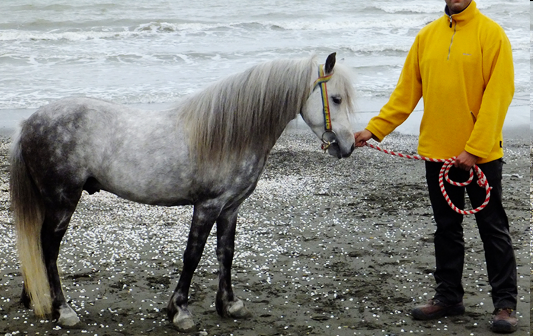
Baltic Sea native horse / Icelandic, Finnish, Estonian, Gotland and Nordland horses (Around 120-150 at the withers, descendant of Mongolian horses, used by viking traders in 700-900 AD and taken to Iceland. Later used by the Swedish cavalry in the 30 years war and by the Finnish army in the Second World War, nowadays harness racing and draught horses)

Siberian native horse / Yakutian pony (Around 120-140 at the withers, related to Baltic and Mongolian horses and at least as old, as well-adapted to Siberian climate as woolly mammoths once were, the hairiest horse there is, used in draught work and herding)
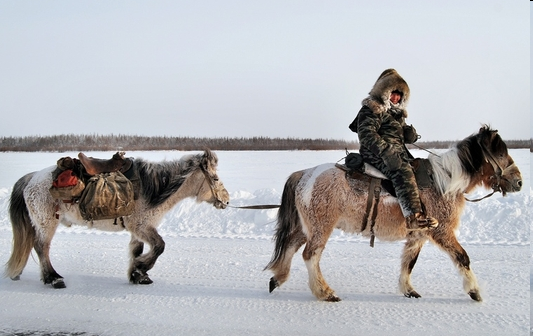
Mediterranean native horse / Skyros pony, Sardinian Giara, Monterufolino (Around 100-140 at the Withers, used and bred by ancient Greeks for cavalry use, influenced by African and Eastern breeds, further had its own influence on Celtic breeds via Roman Empire, still used by park ranger officers in Italy)
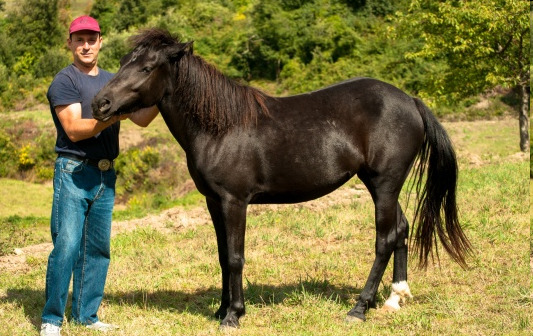
British Isles’ native horse / various “Mountain & Moorland” pony breeds (Around 100-150 at the withers, brought over and mixed by Celts, Romans and Vikings, base for almost every modern sport pony and the deserving main pony of all your British Medieval settings. Some populations still live as feral herds in the British countryside, used as war mounts, draught horses, mine pit ponies, hunting help and race horses)

So hey, now you know!
70K notes
·
View notes
Text
I literally only have one rule in my writing and it is this:
No matter what I put my characters through, they make it. They get to make it to the end of the story and have everything work out and be ok.
Because that’s the story I need. So it’s the kind I write.
92K notes
·
View notes
Video
tumblr
WATCH THIS: MAN SHUTS DOWN ANTISEMITIC WHITE POWER PREACHER
One of my friends in the Boston area took this video and gave me permission to post it. She writes: “ I stood there for twenty minutes, easily. Hitler Youth kept trying to preach about “the evils of the Jews” and the big guy barely let him get a word in edgewise. At one point, the big guy yelled, “I will be here ALL DAY” and the crowd cheered.”
I promise this will be the best thing you see today.
280K notes
·
View notes
Photo
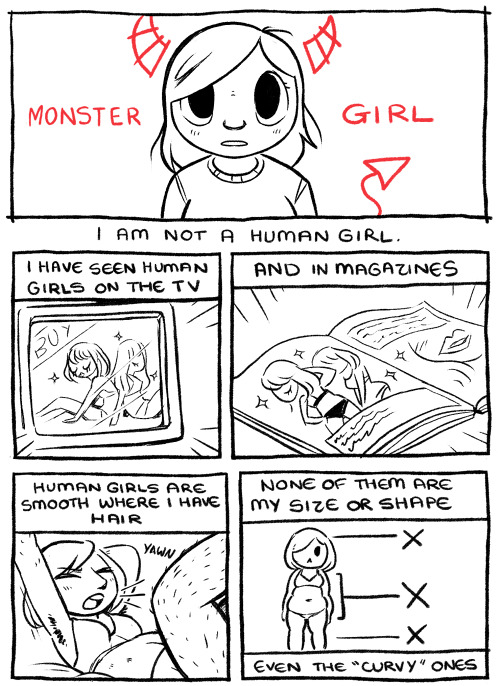
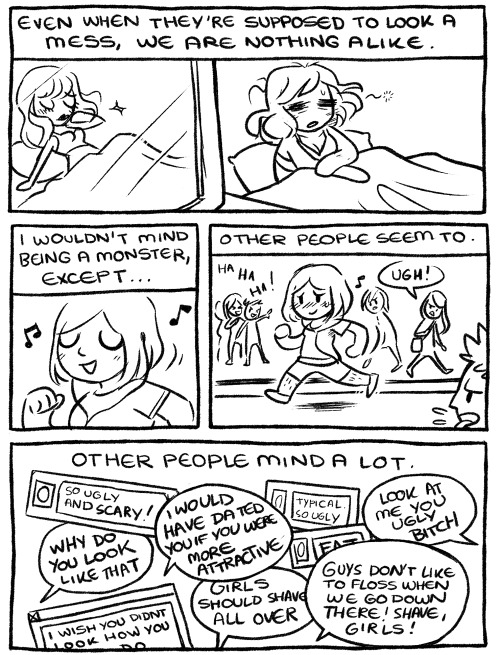
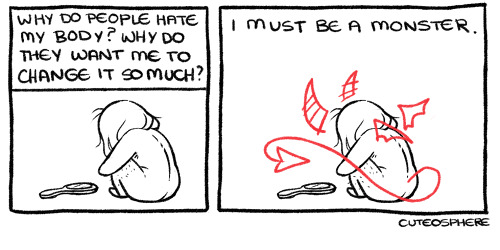
it always disappointed me that Monster Girls are an anime porn thing rather than something used to explore the way society and the media dehumanises women, but oh well
shout out to all my fellow monsters
151K notes
·
View notes
Text
more on writing muslim characters from a hijabi muslim girl
- hijabis get really excited over pretty scarves - they also like to collect pins and brooches - we get asked a lot of questions and it can be annoying or it can be amusing, just depends on our mood and personality and how the question is phrased - common questions include: - “not even water?” (referring to fasting) - hijabis hear a lot of “do you sleep in that?” (we don’t) and “where is your hair?” (in a bun or a braid, usually) - “is it mooze-slim or mozzlem?” (the answer is neither, it’s muslim, with a soft s and accent on the first syllable) - “ee-slam or iz-lamb?” (it’s iss-laam, accent on the first syllable) - “hee-job?” (heh-jahb, accent on the second syllable)
- “kor-an?” (no. quran. say it like koor-annn, accent on the second syllable) - people tend to mess up our names really badly and you just get a sigh and a resigned nod or an awkward smile, maybe a nickname instead - long hair is easy to hide, short hair is harder to wrap up - hijab isn’t just covering hair, it’s also showing as little skin as possible with the exception of face, hands, and feet, and not wearing tight/sheer clothing - that applies to men too, people just don’t like to mention it ( i wonder why) - henna/mehendi isn’t just for special occasions, you’ll see people wearing it for fun - henna/mehendi isn’t just for muslims, either, it’s not a religious thing - henna/mehendi is not just for women, men also wear it, especially on their weddings - there are big mehendi parties in the couple of nights before eid where people (usually just women and kids) gather and do each other’s mehendi, usually just hands and feet - five daily prayers - most muslim kids can stutter through a couple verses of quran in the original arabic text by the age of seven or eight, it does not matter where they live or where they’re from or what language they speak natively - muslim families tend to have multiple copies of the quran - there are no “versions” of the quran, there has only ever been one. all muslims follow the exact same book - muslims have no concept of taking God’s name in vain, we call on God at every little inconvenience - don’t use islamic phrases if you don’t know what they mean or how to use them. we use them often, inside and outside of religious settings. in islam, it is encouraged to mention God often and we say these things very casually, but we take them very seriously - Allahu Akbar means “God is Greatest” (often said when something shocks or surprises us, or if we’re scared or daunted, or when something amazing happens, whether it be good or bad; it’s like saying “oh my god”) - Subhan Allah means “Glory be to God” (i say subhan Allah at the sky, at babies, at trees, whatever strikes me as pleasant, especially if it’s in nature) - Bismillah means “in the name of God” and it’s just something you say before you start something like eating or doing your homework - In Shaa Allah means “if God wills” (example: you’ll be famous, in shaa Allah) (it’s a reminder that the future is in God’s hands, so be humble and be hopeful)
- Astaghfirullah means “i seek forgiveness from Allah” and it’s like “god forgive me” - Alhamdulillah means “all thanks and praise belong to God” and it’s just a little bit more serious than saying “thank god” (example: i passed my exams, alhamdulillah; i made it home okay, alhamdulillah) - when i say we use them casually, i really mean it - teacher forgot to assign homework? Alhamdulillah - our version of “amen” is “ameen” - muslims greet each other with “assalamu alaikum” which just means “peace be on you” and it’s like saying hi - the proper response is “walaikum assalam” which means “and on you be peace” and it’s like saying “you too”
222K notes
·
View notes
Photo
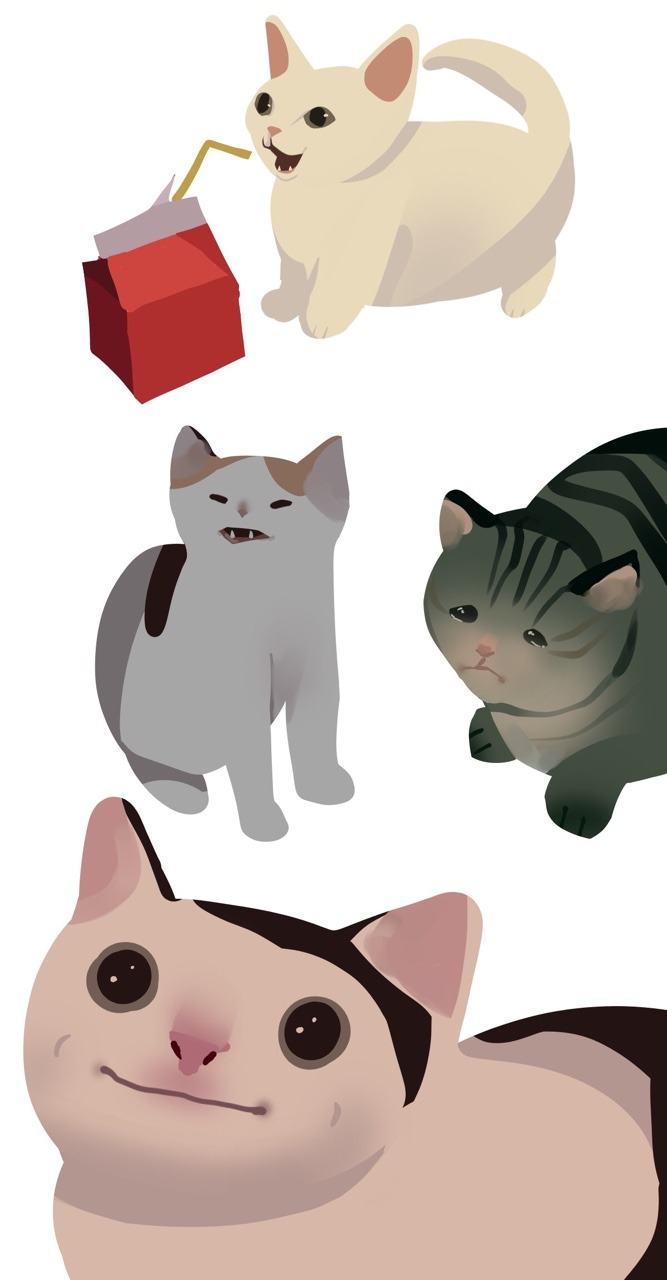
they’re good cats
103K notes
·
View notes












